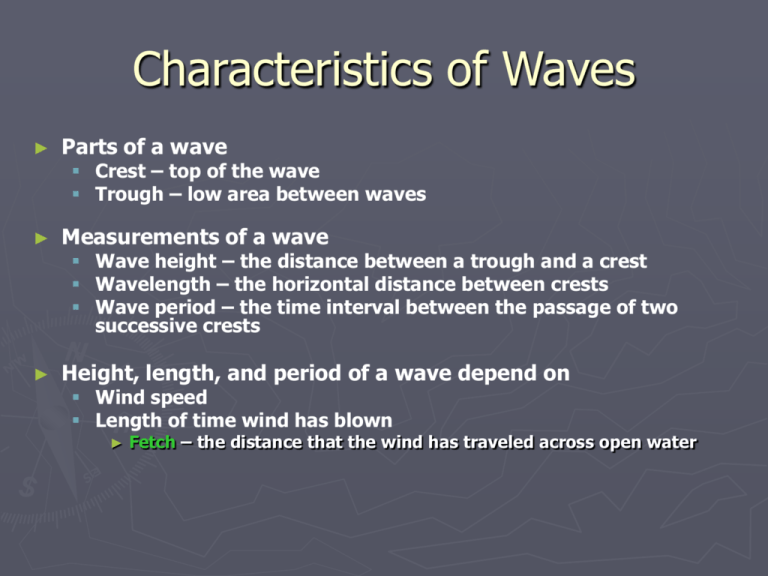Power Point - This Old Earth
advertisement

Characteristics of Waves ► Parts of a wave Crest – top of the wave Trough – low area between waves ► Measurements of a wave Wave height – the distance between a trough and a crest Wavelength – the horizontal distance between crests Wave period – the time interval between the passage of two successive crests ► Height, length, and period of a wave depend on Wind speed Length of time wind has blown ► Fetch – the distance that the wind has traveled across open water Types of Waves ► Wave of oscillation Wave energy moves forward, not the water itself Occur in the open sea in deep water Types of Waves ► Wave of translation Begins to form in shallower water when the water-depth is about one-half the wavelength and the wave begins to “feel bottom” As the speed and length of the wave diminish, the wave grows higher ► The steep wave front collapses and the wave breaks along the shore ► Turbulent water advances up the shore and forms surf Wave refraction (Bending of a wave) ► Causes waves to arrive nearly parallel to the shore ► Consequences of wave refraction Wave energy is concentrated against the sides and ends of headlands Wave energy is spread out in bays and wave attack is weakened ► Produce longshore currents Currents in the surf zone that flow parallel to the coast ► Easily moves fine suspended sand and rolls larger sand and gravel along the bottom Wave Erosion ► Breaking waves exert a great force Grad students at SUNY SB actually using seismograph to record impacts ► Wave erosion is caused by Wave impact and pressure Abrasion by other rock fragments Wave Erosion ► Over time, wave erosion straightens an irregular shoreline ► Caused by moving sand along the beach Waves that reach the shoreline at an angle cause the sediment to move along a beach in a zigzag pattern called beach drift Features of a shorline ► Vary depending on several factors including: The rocks along the shore Currents Wave intensity Whether the coast is stable, sinking, or rising Features caused by wave erosion ► Wave-cut cliffs ► Wave-cut platform ► Features associated with headlands ► Sea arch ► Sea stack Features related to beach drift and longshore currents ► Spits- Elongated ridges of sand extending from the land into the mouth of an adjacent bay Often the end of a spit hooks landward in response to wavegenerated currents ► Baymouth bar – a sand bar that completely crosses a bay ► Tombolo – a ridge of sand that connects an island to the mainland or another island ► Barrier islands Mainly along the Atlantic and Gulf coasts Low ridges of sand that parallel the coast 3 to 30 kilometers offshore Three Basic Responses to Erosion Problems: ► Building structures Jetties ► Usually built in pairs to develop and maintain harbors ► Extend into the ocean at the entrances to rivers and harbors Three Basic Responses to Erosion Problems: ► Groins Built to maintain or widen beaches Constructed at a right angle to the beach to trap sand ► Breakwater Barrier built offshore and parallel to the coast Protects boats from the force of large breaking waves ► Seawall Barrier parallel to shore and close to the beach to protect property Stops waves form reaching the beach areas behind the wall ► Often the building of structures is not an effective means of protection Three Basic Responses to Erosion Problems: ► Beach nourishment The addition of large quantities of sand to the beach system Only an economically viable long-range solution in a few areas ► Abandonment and relocation of buildings away from the beach





